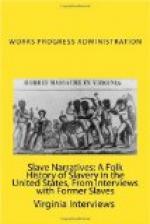In 1865 her father came and took her into Paduca, Kentucky, “a land of freedom.”
When thirteen years old, America did not know A from B, then “glory to God,” a Mr. Greeleaf, a white man, from the north, came down to Kentucky and opened a school for Negro children. That was America’s first chance to learn. He was very kind and very sympathetic. She went to school for a very short while.
Her father was very poor, had nothing at all to give his children.
America’s mistress would not give her any of her clothes. “All she had in this world, was what she had on her back.” Then she was “hired out” for $1.00 a week.
The white people for whom she worked were very kind to her and would try to teach her when her work was done. She was given an old fashioned spelling book and a first reader. She was then “taught much and began to know life.”
She was sent regularly to church and Sunday school. That was when she began to “wake up” to her duty as a free girl.
The Rev. D.W. Dupee was her Sunday school teacher, from him she learned much she had never known before.
At seventeen years of age, she married and “faced a frowning world right.” She had a good husband and ten children, three of whom are living today, one son and two daughters.
She remembers one slave, who had been given five hundred lashes on his back, thrown in his cabin to die. He laid on the floor all night, at dawn he came to himself, and there were blood hounds licking his back.
When the overseers lashed a slave to death, they would turn the bloodhounds out to smell the blood, so they would know “nigger blood,” that would help trace runaway slaves.
Aunt Jane Stringer was given five hundred lashes and thrown in her cabin. The next morning when the overseer came, he kicked her and told her to get up, and wanted to know if she was going to sleep there all day. When she did not answer him, he rolled her over and the poor woman was dead, leaving several motherless children.
When the slaves were preparing to run away, they would put hot pepper on their feet; this would cause the hounds to be thrown off their trail.
Aunt Margaret ran off, but the hounds traced her to a tree; she stayed up in the tree for two days and would not come down until they promised not to whip her any more, and they kept their promise.
Old mistress’ mother was sick a long time, and little America had to keep the flies off of her by waving a paper fly brush over her bed. She was so mean, America was afraid to go too near the bed for fear she might try to grab her and shake her. After she died, she haunted America. Anytime she would go into the room, she could hear her knocking on the wall with her cane. Some nights they would hear her walking up and down the stairs for long periods at a time.
Aunt Catherine ran off, because “ole missie” haunted her so bad.




